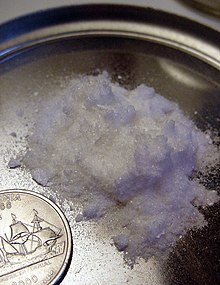Synthetic mescaline. Normally biosynthesized from peyote and some other cacti.[citation needed] Mescaline was the first psychedelic compound to be extracted and isolated.[1]
Psychedelics are a class of drug whose primary action is to trigger psychedelic experiences via serotonin receptor agonism,[2] causing thought and visual/auditory changes, and altered state of consciousness.[3] Major psychedelic drugs include mescaline, LSD, psilocybin, and DMT. Studies show that psychedelics are physiologically safe and do not lead to addiction. In fact, two studies conducted using psilocybin in a psychotheraputic setting reveal that psychedelic drugs may assist with treating alcohol and nicotine addiction.[4]
Differing with other psychoactive drugs, such as stimulants and opioids, psychedelics tend to qualitatively alter ordinary conscious experience. Whereas stimulants cause energized feelings and opioids produce a relaxed euphoric state, the psychedelic experience is often compared to non-ordinary forms of consciousness such as trance, meditation, yoga, religious ecstasy, dreaming and even near-death experiences. Most psychedelic drugs fall into one of the three families of chemical compounds: tryptamines, phenethylamines, or lysergamides.
Many psychedelic drugs are illegal worldwide under the UN conventions, occasionally excepting use in a religious or research context. Despite these controls, recreational use of psychedelics is common.
Origin of term
The term psychedelic is derived from the Greek words ψυχή (psyche, "soul, mind") and δηλείν (delein, "to manifest"), hence "soul-manifesting", the implication being that psychedelics can access the soul and develop unused potentials of the human mind.[7] The word was coined in 1956 by British psychiatrist, Humphry Osmond, the spelling loathed by American ethnobotanist, Richard Schultes, but championed by the American psychologist, Timothy Leary.[8]Aldous Huxley had suggested to Humphry Osmond in 1956 his own coinage phanerothyme (Greek "phaneroein-" visible + Greek "thymos" soul, thus "visible soul").[9] Recently, the term entheogenic has come into use to denote the use of psychedelic drugs in a religious/spiritual/mystical context.
Traditional use
Psychedelics have a long history of traditional use in medicine and religion, for their perceived ability to promote physical and mental healing. In this context, they are often known as entheogens. Native American practitioners using mescaline-containing cacti (most notably peyote, San Pedro, and Peruvian torch) have reported success against alcoholism, and Mazatec practitioners routinely use psilocybin mushrooms for divination and healing. Ayahuasca, which contains the potent psychedelic DMT, is used in Peru and other parts of South America for spiritual and physical healing as well as in religious festivals.Examples
Doses of lysergic acid diethylamide (LSD)
Classical or serotonergic psychedelics (agonists for the 5-HT2A serotonin receptors) include LSD (also known as "acid"), psilocin (the active constituent of psilocybin mushrooms, commonly known as "magic mushrooms" or "shrooms"), mescaline (the active constituent of peyote), and DMT (the active constituent of ayahuasca and an endogenous compound produced in the human body).
Pharmacological classes and effects
Serotonergic psychedelics (5-HT2A receptor agonists)
This class of psychedelics includes the classical hallucinogens, including the lysergamides like LSD and LSA, tryptamines like psilocybin and DMT, and phenethylamines like mescaline and 2C-B. Many of these psychedelics cause remarkably similar effects, despite their different chemical structure. However, many users report that the three families have subjectively different qualities in the "feel" of the experience, which are difficult to describe. At lower doses, these include sensory alterations, such as the warping of surfaces, shape suggestibility, and color variations. Users often report intense colors that they have not previously experienced, and repetitive geometric shapes are common. Higher doses often cause intense and fundamental alterations of sensory perception, such as synesthesia or the experience of additional spatial or temporal dimensions.[10] Some compounds, such as 2C-B, have extremely tight "dose curves", meaning the difference between a non-event and an overwhelming disconnection from reality can be very slight.[citation needed] There can be very substantial differences between the drugs, however. For instance, 5-MeO-DMT rarely produces the visual effects typical of other psychedelics and ibogaine (a 'complex tryptamine') is also an NMDA receptor antagonist and κ-opioid receptor agonist in addition to being an agonist for the 5-HT2A receptors, resulting in dissociative effects as well (see dissociatives below).Almost all antidepressant drugs, especially atypical ones like mirtazapine and trazodone, are 5-HT2A antagonists, from moderate to very strong, and thus often totally disrupts psychedelic effects. Furthermore, persons on chronic antidepressive medications virtually can't get any effects from serotonergic psychedelic drugs even after discontinuing antidepressant drugs.



